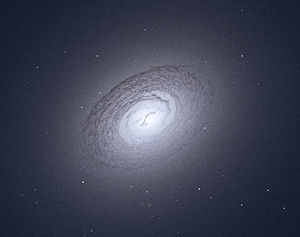NGC 3607
| Galaxy NGC 3607 |
|
|---|---|

|
|
| Photo from the Hubble Space Telescope | |
| AladinLite | |
| Constellation | lion |
|
Position equinox : J2000.0 , epoch : J2000.0 |
|
| Right ascension | 11 h 16 m 54.6 s |
| declination | + 18 ° 03 ′ 06 ″ |
| Appearance | |
| Morphological type | SA (s) 0 ^ 0 ^: / Sy 2 / AGN2 |
| Brightness (visual) | 9.9 likes |
| Brightness (B-band) | 10.9 likes |
| Angular expansion | 4.6 ′ × 4 ′ |
| Position angle | 120 ° |
| Surface brightness | 13.1 mag / arcmin² |
| Physical data | |
| Affiliation |
Leo II group NGC 3607 group WBL 319 |
| Redshift | 0.003142 ± 0.000017 |
| Radial velocity | 942 ± 5 km / s |
|
Stroke distance v rad / H 0 |
(39 ± 3) x 10 6 ly (12.0 ± 0.8) Mpc |
| history | |
| discovery | Wilhelm Herschel |
| Discovery date | March 14, 1784 |
| Catalog names | |
| NGC 3607 • UGC 6297 • PGC 34426 • CGCG 096-021 • MCG + 03-29-020 • 2MASX J11165465 + 1803065 • GC 2358 • H II 50 • h 845 • NVSS J111654 + 180304 • LDCE 778 NED030 • KPG 278A • HOLM 240A | |
NGC 3607 is an elliptical Quasar from Hubble type E / S0 in the constellation Leo on the ecliptic . It is an estimated 39 million light years away from the Milky Way and about 55,000 light years in diameter. Together with NGC 3605 and NGC 3608 , it forms the galaxy trio Holm 240 .
The object was discovered by William Herschel on March 14, 1784 .
Web links
Commons : NGC 3607 - collection of images, videos, and audio files
